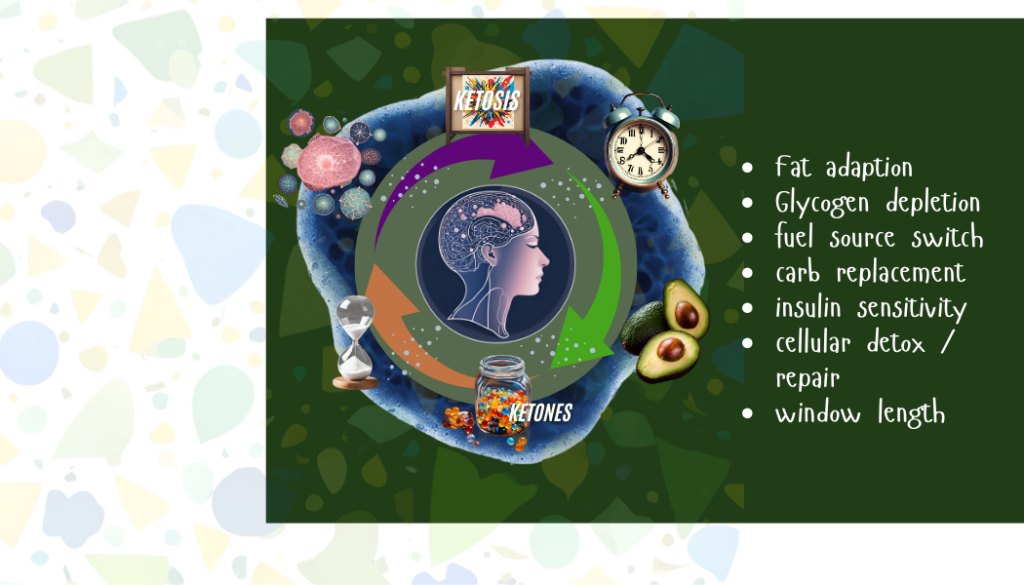Revive & Thrive
Harness the Power of Nature's Healing to Rebuild and Renew
BLOG

Shelley DiAngelo, registered nurse and certified diabetes educator
Shelley's passion is to help you feel, look, and be your healthiest from the inside out.
Understanding Ketosis and Fasting: A Comprehensive Guide
What is Ketosis?
Ketosis is a natural metabolic state where your body uses fat, rather than carbohydrates, as its primary energy source. Normally, your body relies on glucose from carbohydrates for fuel. However, when carbohydrate intake is significantly reduced, your liver starts breaking down fats into molecules called ketones, which serve as an alternative energy source.
Ketosis is a cornerstone of ketogenic diets and fasting practices. It offers a powerful way to tap into your body’s fat reserves, making it a highly efficient mechanism for weight loss, improved energy, and better metabolic health.

Why is Ketosis Important for Fasters?
For individuals practicing fasting, achieving ketosis can amplify the benefits of their fast by:
Enhancing Fat Burning: With glucose depleted during a fast, your body shifts into ketosis more readily, accelerating fat loss.
Reducing Hunger and Cravings: Ketones have appetite-suppressing effects, making longer fasting periods more manageable.
Increasing Mental Clarity: Ketones are a clean energy source for the brain, often leading to sharper focus and reduced mental fog.
Boosting Energy Levels: Contrary to the dips in energy that occur with low blood sugar, ketones provide a steady fuel source, supporting physical and mental endurance.
The Benefits of Ketosis Beyond Fasting
While ketosis is an essential tool during fasting, it’s also beneficial for overall health. Key advantages include:
Improved Insulin Sensitivity: Ketosis helps regulate blood sugar levels and reduces insulin resistance, lowering the risk of type 2 diabetes.
Enhanced Cellular Repair: Ketosis triggers autophagy, a process where your body cleans out damaged cells, promoting regeneration and longevity.
Reduced Inflammation: By minimizing glucose spikes and promoting fat metabolism, ketosis can lower inflammation markers, supporting joint health and reducing chronic pain.
Like Nature, Ketosis is the body’s remarkable adaptation for survival
How to Get Into Ketosis
Achieving ketosis requires a combination of dietary and lifestyle changes, including:
Reducing Carbohydrate Intake: Limit your daily carbs to 20-50 grams. Focus on leafy greens, low-carb vegetables, and healthy fats while avoiding sugars and starchy foods.
Increasing Healthy Fats: Incorporate sources like avocados, nuts, seeds, olive oil, and fatty fish into your meals.
Practicing Intermittent Fasting: Fasting accelerates glycogen depletion and encourages your body to produce ketones faster.
Staying Active: Exercise can deplete glycogen stores more quickly, pushing your body into ketosis sooner.
Staying Hydrated: Drinking plenty of water supports metabolic processes and helps prevent the “keto flu”—symptoms like fatigue and headaches that sometimes occur as your body adapts to ketosis.
How to Know If You Are in Ketosis Without Testing
While ketone testing tools like breath analyzers or urine strips can confirm ketosis, there are several signs your body provides when you’re in this state:
Increased Energy: Many people report feeling more energized and alert once their body has adapted to burning fat.
Decreased Appetite: Ketosis naturally suppresses hunger, making it easier to go without food for longer periods.
Dry Mouth or Metallic Taste: This can occur as your body expels ketones through breath and saliva.
Improved Focus: A noticeable improvement in mental clarity often accompanies ketosis.
Weight Loss: Rapid water weight loss is common at first, followed by steady fat loss as ketosis continues.
Tips to Maximize Your Ketosis:
Monitor Your Progress: Pay attention to how you feel, and adjust your diet or fasting routine as needed.
Balance Electrolytes: Add sodium, potassium, and magnesium-rich foods or supplements to avoid muscle cramps and fatigue.
Be Patient: Transitioning into ketosis can take a few days. Stay consistent with your carb reduction and fasting plan.
Final Thoughts
Ketosis is a powerful metabolic state that complements fasting by enhancing fat burning, mental clarity, and energy levels. By understanding how to enter and sustain ketosis, you can unlock significant health benefits while making your fasting journey more effective and enjoyable.

We are proud to be your
holistic health providers
Thank you for exploring our blog. We invite you to learn more about our services and discuss how we can assist with your specific needs. We are dedicated to serving the holistic health community and look forward to connecting with you.
Love What You See? Share the Wellness! 🌿✨”
Encourage your community to spread the word with a simple click! Stay connected, inspire others, and help more people discover the power of holistic health. Tag us & let’s grow this wellness movement together!
Leave a comment. We’d love to hear your thoughts!

